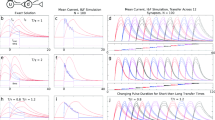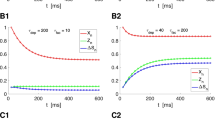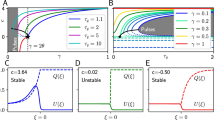Abstract
We study the spatiotemporal dynamics of neuronal networks with spike frequency adaptation. In particular, we compare the effects of adaptation being either a linear or nonlinear function of neural activity. We find that altering parameters controlling the strength of synaptic connections in the network can lead to spatially structured activity suggestive of symptoms of hallucinogen persisting perception disorder (HPPD). First, we study how both networks track spatially homogeneous flickering stimuli, and find input is encoded as continuous at lower flicker frequencies when the network’s synapses exhibit more net excitation. Mainly, we study instabilities of stimulus-driven traveling pulse solutions, representative of visual trailing phenomena common to HPPD patients. Visual trails are reported as discrete afterimages in the wake of a moving input. Thus, we analyze several solutions arising in response to moving inputs in both networks: an ON state, stimulus-locked pulses, and traveling breathers. We find traveling breathers can arise in both networks when an input moves beyond a critical speed. These possible neural substrates of visual trails occur at slower speeds when the modulation of synaptic connectivity is increased.





















Similar content being viewed by others
References
Abraham, H. D. (1983). Visual phenomenology of the LSD flashback. Archives of General Psychiatry, 40(8), 884–889.
Abraham, H. D., & Duffy, F. H. (1996). Stable quantitative EEG difference in post-LSD visual disorder by split-half analysis: Evidence for disinhibition. Psychiatry Research, 67(3), 173–187.
Abraham, H. D., & Duffy, F. H. (2001). EEG coherence in post-LSD visual hallucinations. Psychiatry Research, 107(3), 151–163.
Abraham, H. D., & Wolf, E. (1988). Visual function in past users of LSD: Psychophysical findings. Journal of Abnormal Psychology, 97(4), 443–447.
Amari, S. (1977). Dynamics of pattern formation in lateral-inhibition type neural fields. Biological Cybernetics, 27(2), 77–87.
Ben-Yishai, R., Bar-Or, R. L., & Sompolinsky, H. (1995). Theory of orientation tuning in visual cortex. Proceedings of the National Academy of Sciences of the United States of America, 92(9), 3844–3848.
Ben-Yishai, R., Hansel, D., & Sompolinsky, H. (1997). Traveling waves and the processing of weakly tuned inputs in a cortical network module. Journal of Computational Neuroscience, 4(1), 57–77.
Benda, J., & Herz, A. V. M. (2003). A universal model for spike-frequency adaptation. Neural Computation, 15(11), 2523–2564.
Boyer, E. W., & Shannon, M. (2005). The serotonin syndrome. New England Journal of Medicine, 352(11), 1112–1120.
Bressloff, P., Cowan, J., Golubitsky, M., Thomas, P., & Wiener, M. (2001). Geometric visual hallucinations, Euclidean symmetry and the functional architecture of striate cortex. Proceedings of the Royal Society of London. Series B, Biological Sciences, 356(1407), 299–330.
Bressloff, P. C., & Cowan, J. D. (2002). An amplitude equation approach to contextual effects in visual cortex. Neural Computation, 14(3), 493–525.
Bressloff, P. C., & Kilpatrick, Z. P. (2011). Two-dimensional bumps in piecewise smooth neural fields with synaptic depression. SIAM Journal of Applied Mathematics, 71(2), 379–408.
Chervin, R. D., Pierce, P. A., & Connors, B. W. (1988). Periodicity and directionality in the propagation of epileptiform discharges across neocortex. Journal of Neurophysiology, 60(5), 1695–1713.
Chossat, P., & Faugeras, O. (2009). Hyperbolic planforms in relation to visual edges and textures perception. PLoS Computational Biology, 5(12), e1000625.
Cohen, S., & Ditman, K. S. (1963). Prolonged adverse reactions to lysergic acid diethylamide. Archives of General Psychiatry, 8(5), 475–480.
Coombes, S. (2005). Waves, bumps, and patterns in neural field theories. Biological Cybernetics, 93(2), 91–108.
Coombes, S., & Owen, M. R. (2004). Evans functions for integral neural field equations with Heaviside firing rate function. SIAM Journal on Applied Dynamical Systems, 3(4), 574–600.
Coombes, S., & Owen, M. R. (2005). Bumps, breathers, and waves in a neural network with spike frequency adaptation. Physics Review Letters, 94(14), 148102.
Coombes, S., & Schmidt, H. (2010). Neural fields with sigmoidal firing rates: Approximate solutions. Discrete and Continuous Dynamical Systems A, 28(4), 1369–1379.
Dubois, J., & VanRullen, R. (2011). Visual trails: Do the doors of perception open periodically? PLos Biology, 9(5), e1001056.
Ermentrout, G. B., & Cowan, J. D. (1979). A mathematical theory of visual hallucination patterns. Biological Cybernetics, 34(3), 137–50.
Ermentrout, G. B., Jalics, J. Z., & Rubin, J. E. (2010). Stimulus-driven traveling solutions in continuum neuronal models with a general smooth firing rate function. SIAM Journal of Applied Mathematics, 70(8), 3039–3064.
Faugeras, O., Veltz, R., & Grimbert, F. (2009). Persistent neural states: Stationary localized activity patterns in the nonlinear continuous n-population, q-dimensional neural networks. Neural Computation, 21, 147–187.
Folias, S. E., & Bressloff, P. C. (2004). Breathing pulses in an excitatory neural network. SIAM Journal on Applied Dynamical Systems, 3(3), 378–407.
Folias, S. E., & Bressloff, P. C. (2005a). Breathers in two-dimensional neural media. Physics Review Letters, 95(20), 208107.
Folias, S. E., & Bressloff, P. C. (2005b). Stimulus-locked traveling waves and breathers in an excitatory neural network. SIAM Journal of Applied Mathematics, 65(6), 2067–2092.
Fontenelle, L. F. (2008). Topiramate-induced palinopsia. Journal of Neuropsychiatry and Clinical Neurosciences, 20(2), 249–250.
Frosch, W. A., Robbins, E. S., & Stern, M. (1965). Untoward reactions to lysergic acid diethylamide (LSD) resulting in hospitalization. New England Journal of Medicine, 273, 1235–1239.
Guo, Y., & Chow, C. C. (2005). Existence and stability of standing pulses in neural networks: I. Existence. SIAM Journal on Applied Dynamical Systems, 4(2), 217–248.
Halpern, J. H., & Pope, H. G. (2003). Hallucinogen persisting perception disorder: What do we know after 50 years? Drug and Alcohol Dependence, 69(2), 109–119.
Hansel, D., & Sompolinsky, H. (1998). Modeling feature selectivity in local cortical circuits. In C. Koch, & I. Segev (Eds.), Methods in neuronal modeling: From ions to networks (chap. 13, pp. 499–567). Cambridge: MIT.
Horowitz, M. L. (1969). Flashbacks: Recurrent intrusive images after the use of LSD. American Journal of Psychiatry, 126(4), 565–569.
Huang, X., Troy, W. C., Yang, Q., Ma, H., Laing, C. R., Schiff, S. J., et al. (2004). Spiral waves in disinhibited mammalian neocortex. Journal of Neuroscience, 24(44), 9897–9902.
Hubel, D. H., & Wiesel, T. N. (1977). Ferrier lecture. Functional architecture of macaque monkey visual cortex. Proceedings of the Royal Society of London. Series B, Biological Sciences, 198(1130), 1–59.
Ihde-Scholl, T., & Jefferson, J. W. (2001). Mitrazapine-associated palinopsia. Journal of Clinical Psychiatry, 62(5), 373.
Kawasaki, A., & Purvin, V. (1996). Persistent palinopsia following ingestion of lysergic acid diethylamide (LSD). Archives of Ophthalmology, 114(1), 47–50.
Kilpatrick, Z. P., & Bressloff, P. C. (2010a). Binocular rivalry in a competitive neural network with synaptic depression. SIAM Journal on Applied Dynamical Systems, 9, 1303–1347.
Kilpatrick, Z. P., & Bressloff, P. C. (2010b). Effects of synaptic depression and adaptation on spatiotemporal dynamics of an excitatory neuronal network. Physica D, 239(9), 547–560. Mathematical neuroscience.
Kilpatrick, Z. P., & Bressloff, P. C. (2010c). Stability of bumps in piecewise smooth neural fields with nonlinear adaptation. Physica D, 239(12), 1048–1060.
Kilpatrick, Z. P., Folias, S. E., & Bressloff, P. C. (2008). Traveling pulses and wave propagation failure in inhomogeneous neural media. SIAM Journal on Applied Dynamical Systems, 7(1), 161–185.
Kishimoto, K., & Amari, S. (1979). Existence and stability of local excitations in homogeneous neural fields. Journal of Mathematical Biology, 7, 303–318.
Kraus, R. P. (1996). Visual “trails” with nefazodone treatment. American Journal of Psychiatry, 153(10), 1365–1366.
Laing, C. R., & Troy, W. C. (2003). PDE methods for nonlocal models. SIAM Journal on Applied Dynamical Systems, 2(3), 487–516.
Lerner, A. G., Finkel, B., Oyffe, I., Merenzon, I., & Sigal, M. (1998). Clonidine treatment for hallucinogen persisting perception disorder. American Journal of Psychiatry, 155(10), 1460.
Lerner, A. G., Skladman, I., Kodesh, A., Sigal, M., & Shufman, E. (2001). LSD-induced hallucinogen persisting perception disorder treated with clonazepam: Two case reports. Israel Journal of Psychiatry and Related Sciences, 38(2), 133–136.
Madison, D. V., & Nicoll, R. A. (1984). Control of the repetitive discharge of rat CA1 pyramidal neurones in vitro. Journal of Physiology, 354, 319–331.
Moskowitz, D. (1971). Use of haloperidol to reduce lsd flashbacks. Military Medicine, 136(9), 754–756.
Nichols, C. D., & Sanders-Bush, E. (2002). A single dose of lysergic acid diethylamide influences gene expression patterns within the mammalian brain. Neuropsychopharmacology, 26(5), 634–642.
Oster, G. (1970) Phosphenes. Scientific American, 222(2), 82–87.
Pinto, D. J., & Ermentrout, G. B. (2001). Spatially structured activity in synaptically coupled neuronal networks: I. Traveling fronts and pulses. SIAM Journal on Applied Mathematics, 62(1), 206–225.
Rosenthal, S. H. (1964). Persistent hallucinosis following repeated administration of hallucinogenic drugs. American Journal of Psychiatry, 121, 238–244.
Shusterman, V., & Troy, W. C. (2008). From baseline to epileptiform activity: A path to synchronized rhythmicity in large–scale neural networks. Physical Review E, 77(6), 061911.
Stocker, M., Krause, M., & Pedarzani, P. (1999). An apamin-sensitive Ca2 +-activated K+ current in hippocampal pyramidal neurons. Proceedings of the National Academy of Sciences of the United States of America, 96(8), 4662–4667.
Troy, W. C., & Shusterman, V. (2007). Patterns and features of families of traveling waves in large-scale neuronal networks. SIAM Journal on Applied Dynamical Systems, 6(1), 263–292.
Tsai, P. H., & Mendez, M. F. (2009). Akinetopsia in the posterior cortical variant of Alzheimer disease. Neurology, 73(9), 731–732.
Wilson, H. R., & Cowan, J. D. (1972). Excitatory and inhibitory interactions in localized populations of model neurons. Biophysics Journal, 12(1), 1–24.
York, L. C., & van Rossum, M. C. W. (2009). Recurrent networks with short term synaptic depression. Journal of Computational Neuroscience, 27(3), 607–620.
Young, C. R. (1997). Sertraline treatment of hallucinogen persisting perception disorder. Journal of Clinical Psychiatry, 58(2), 85.
Zhang, L. (2004). Existence, uniqueness and exponential stability of traveling wave solutions of some integral differential equations arising from neuronal networks. Journal of Differential Equations, 197(1), 162–196.
Acknowledgements
We would like to thank Julien Dubois for sharing with us reports from subjects regarding the specifics of visual trails due to HPPD. We also thank Henry Abraham for use of his patient’s drawing of a visual trails experience. ZPK is supported by an NSF Mathematical Sciences Postdoctoral Research Fellowship (DMS-1004422). GBE is supported by an NSF grant (DMS-0817131).
Author information
Authors and Affiliations
Corresponding author
Additional information
Action Editor: P. Dayan
Appendices
Appendix A: ON state in system with nonlinear adaptation
In this appendix, we derive Eq. (4.3), giving the critical speed c * at which the ON state ceases to exist in the full network with nonlinear adaptation (2.2). Thus, we study the equations,
Changing coordinates to the rotating frame ξ = x − ct, so u = U(ξ) and v = V(ξ), and assuming the ON state exits (U(ξ) > V(ξ) + κ), we have
Solving this pair of first order differential equations by along with periodic boundary conditions yields
and V(ξ) = β. For the ON state to exist, synaptic input must be superthreshold, U(ξ) > κ + β for all ξ ∈ ( − π, π). Simply requiring this of the minimum, U(ξ m ) > κ + β, yields the following inequality
We then identify the critical stimulus speed value c * at which the ON state ceases to exist as that for which the inequality (A.3) becomes a strict equality. Thus, we can solve the equality explicitly for Eq. (4.3):
so when c > c *, the ON state exists.
Appendix B: Existence of pulses in network with nonlinear adaptation
Here, we present our construction of stimulus-locked traveling pulse solutions in the network with nonlinear adaptation (2.2) and Heaviside firing rate function (2.5). Changing to traveling wave coordinates ξ = x − ct, a pulse of width Δ ∈ (0, 2 π) has superthreshold region ξ ∈ (π − Δ, π) , where we can arbitrarily select the leading edge’s location due the translation invariance of the problem. We also specify a spatial shift Δ I of the input \(I(x,t) = I_0 \cos^2 ( ( \xi + \Delta_I)/2)\). This yields
where
Solving this set of equations with periodic boundary conditions gives
Therefore, to specify the pulse width Δ and associated shift to the input Δ I , we impose self consistency by requiring that the input current U(ξ) − V(ξ) specified by Eqs. (B.1) and (B.2) cross firing threshold κ at the leading and trailing edge of the pulse such that U(π) − V(π) = U(π − Δ) − V(π − Δ) = κ. This generates the following nonlinear system of equations
Appendix C: Stability of pulses in network with nonlinear adaptation
In this appendix, we derive the linear stability approximation for traveling pulses in the network with nonlinear adaptation. As in the case of the network with linear adaptation, we start by considering the evolution of small, smooth perturbations to the traveling pulse solution (U(ξ), V(ξ)), such that \(u( \xi , t) = U( \xi ) + \bar{\psi} ( \xi , t)\) and \(v( \xi , t) = V( \xi ) + \bar{\phi} ( \xi , t)\). Upon plugging these expression into the system (2.2) and expanding to first order in \(( \bar{\psi} , \bar{\phi} )\), we arrive at the system of linear equations
To characterize some of the spectrum of this operator, we can look, in particular, for solutions of the form \(( \bar{\psi}, \bar{\phi}) = {\rm e}^{\lambda t} ( \psi ( \xi ) , \phi ( \xi ))\) and using the identity
where
Due to the jump discontinuity in V′( ξ) at the threshold crossing points, either V′( π) = V + ′( π) or V′(π) = V − ′(π), and similarly either V′(π − Δ) = V + ′ (π − Δ) or V′(π − Δ) = V − ′(π − Δ) where
Note that, following recent studies of the stability of spatially structured solutions in piecewise smooth neural fields (Kilpatrick and Bressloff 2010a, c; Bressloff and Kilpatrick 2011), the particular choice to make for each V′(π) and V′(π − Δ) will be assigned based the sign of the difference of perturbations (ψ(ξ) − ϕ(ξ)) in both places the expression appears in the identity (C.1). This is due to the piecewise smooth nature of V′ at the boundary of the pulse. Upon assuming a fixed sign of these perturbations, we can only calculate real eigenvalues associated with the resulting piecewise defined system. This is due to the fact that solutions ψ(ξ) − ϕ(ξ) with associated complex eigenvalues will oscillate above and below zero, violating our assumption of a fixed sign. Thus, we obtain the following system
where
Therefore, the stability of the stimulus-locked traveling pulse given by Eqs. (B.1) and (B.2) can be calculated using spectrum of the eigenvalue problem (C.6). First, note that the values bounding the essential spectrum λ = − 1 and λ = − α − 1 have infinite multiplicity and will not contribute to any instabilities. Upon omitting these value from our analysis, we can proceed by solving for the eigenfunctions. It is straightforward to do so by directly integrating both equations, treating the ψ(π) , ψ(π − Δ), ϕ(π), ϕ(π − Δ) terms as constants, to find
where
Requiring self-consistency of the the solutions (C.8) and (C.9), we generate the following 2 × 2 system of equations \({\boldsymbol \psi} - {\boldsymbol \phi} = {\mathcal A}_p ({\boldsymbol \psi} - {\boldsymbol \phi})\) where
with
and
Now in order to examine the stability, we look for nontrivial solutions of \({\boldsymbol \psi} - {\boldsymbol \phi} = {\mathcal A}_p ({\boldsymbol \psi} - {\boldsymbol \phi})\) such that \({\mathcal E}( \lambda ) = 0\), where \({\mathcal E}( \lambda ) = \det ( {\mathcal A}_p - I)\), is the Evans function of the traveling pulse solution (B.1) and (B.2). The traveling pulse will surely not be linearly stable in the case that λ > 0 for all real λ such that \({\mathcal E}( \lambda ) = 0\). We cannot ensure linear stability, since we have omitted eigensolutions with complex eigenvalues. However, we find that, in many instances, our analysis accurately predicts the nonlinear stability of the associated stimulus-locked traveling pulse. The Evans function is then piecewise defined for four possible classes of eigenfunction: (i) ψ(π) > ϕ(π) and ψ(π − Δ) > ϕ(π − Δ); (ii) ψ(π) > ϕ(π) and ψ(π − Δ) < ϕ(π − Δ); (iii) ψ(π) < ϕ(π) and ψ(π − Δ) > ϕ(π − Δ); and (iv) ψ(π) < ϕ(π) and ψ(π − Δ) < ϕ(π − Δ).
Rights and permissions
About this article
Cite this article
Kilpatrick, Z.P., Bard Ermentrout, G. Hallucinogen persisting perception disorder in neuronal networks with adaptation. J Comput Neurosci 32, 25–53 (2012). https://doi.org/10.1007/s10827-011-0335-y
Received:
Revised:
Accepted:
Published:
Issue Date:
DOI: https://doi.org/10.1007/s10827-011-0335-y




